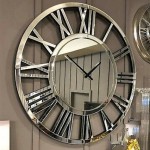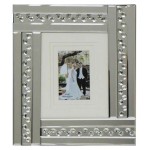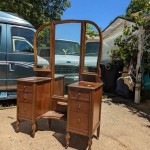French Style Mirrors: An Exploration of Design, History, and Application
French style mirrors, characterized by their ornate frames, elegant detailing, and historical connection to French design movements, serve as both functional objects and decorative art pieces. These mirrors transcend mere reflection, imbuing spaces with a sense of sophistication, light, and historical charm. Their enduring popularity stems from their versatility and ability to complement a wide range of interior design styles, from traditional to contemporary.
Understanding French style mirrors requires delving into their historical context. The evolution of French mirror design is inextricably linked to the opulence and artistry of the French court, particularly during the reigns of Louis XIV, XV, and XVI. These periods witnessed a flourishing of craftsmanship, with skilled artisans creating intricate and lavish pieces intended to adorn the palaces and residences of the aristocracy. The mirrors of this era were not simply utilitarian objects, but symbols of wealth, status, and refined taste.
The materials used in French style mirrors further contribute to their distinctive aesthetic. Gilded wood, often employing gold leaf, is a hallmark of many classic designs. Other common materials include carved wood, plaster, and gesso, all meticulously crafted and ornamented. The mirror glass itself has also undergone changes throughout history, evolving from earlier, less refined techniques to the clear, high-quality glass available today. The combination of these materials and techniques results in a finished product that embodies both beauty and craftsmanship.
Key Design Elements of French Style Mirrors
French style mirrors encompass a range of design elements that contribute to their overall aesthetic appeal. These elements often vary depending on the specific period and style being emulated, but certain characteristics are consistently present.
Ornate Frames: The frames of French style mirrors are typically the most striking feature. They are often characterized by intricate carvings, scrolling patterns, and decorative motifs. Common motifs include acanthus leaves, floral designs, shells, and geometric patterns. These details are frequently gilded, adding a touch of luxury and highlighting the craftsmanship involved.
Shaped Silhouettes: Beyond the ornamentation, the overall shape of the mirror frame contributes significantly to its style. Common shapes include rectangular, oval, and round, but more elaborate designs, such as cartouche-shaped mirrors or those with arched tops, are also prevalent. The silhouette often reflects the architectural trends of the period it emulates, further enhancing its visual impact.
Period-Specific Details: Different periods of French design have distinct characteristics that are reflected in mirror styles. For example, Louis XV mirrors often feature asymmetrical designs and rococo motifs, while Louis XVI mirrors tend to be more symmetrical and neoclassical in style. Identifying these period-specific details is crucial for understanding and appreciating the nuances of French mirror design.
Gilding and Finishes: The application of gilding is a defining characteristic of many French style mirrors. Gold leaf is painstakingly applied to the frame, creating a shimmering surface that catches the light and enhances the beauty of the carvings. Distressing techniques, such as antiquing or aging, are often used to create a more vintage or timeworn appearance, adding depth and character to the piece.
Historical Influences on French Mirror Design
The evolution of French mirror design is deeply intertwined with the historical and artistic movements of France. Understanding these influences is essential for appreciating the nuances of different styles and periods.
The Baroque Era (Louis XIV): The reign of Louis XIV, often referred to as the Sun King, marked a period of unparalleled opulence and grandeur. Baroque style mirrors from this era are characterized by their large size, elaborate ornamentation, and use of gold leaf. These mirrors were intended to reflect the wealth and power of the monarchy and were often placed in grand halls and salons.
The Rococo Era (Louis XV): The Rococo period, associated with Louis XV, saw a shift towards more delicate and asymmetrical designs. Rococo mirrors are known for their flowing lines, intricate carvings, and use of natural motifs, such as flowers, shells, and leaves. Gilding was still prevalent, but the overall aesthetic was lighter and more playful than the Baroque style.
The Neoclassical Era (Louis XVI): The reign of Louis XVI ushered in a period of Neoclassicism, which drew inspiration from ancient Greek and Roman art. Neoclassical mirrors are characterized by their symmetrical designs, geometric shapes, and use of classical motifs, such as columns, garlands, and medallions. While gilding was still used, the overall aesthetic was more restrained and elegant than the previous eras.
The Influence of Venetian Mirrors: Venetian mirror-making techniques, known for their clarity and quality, significantly influenced French mirror production. French artisans often adopted and adapted Venetian techniques, incorporating them into their own designs. This exchange of knowledge and expertise contributed to the development of distinctive French mirror styles.
Applications of French Style Mirrors in Interior Design
French style mirrors are versatile design elements that can be incorporated into a variety of interior spaces. Their ability to reflect light, create the illusion of space, and add a touch of elegance makes them a valuable asset for both residential and commercial settings.
Focal Points: A large French style mirror can serve as a focal point in a room, drawing the eye and creating a sense of drama. Placing a mirror above a fireplace mantel, console table, or bed can instantly elevate the space and add a touch of sophistication.
Enhancing Light and Space: French style mirrors are particularly effective at enhancing natural light and creating the illusion of a larger space. Placing a mirror opposite a window can amplify the amount of light entering the room, making it feel brighter and more airy. Similarly, strategically placed mirrors can create the illusion of depth, making a small room feel more spacious.
Complementing Various Design Styles: French style mirrors are adaptable enough to complement a wide range of interior design styles. They can add a touch of elegance to a traditional space, create a striking contrast in a modern setting, or enhance the romantic charm of a bohemian-inspired room. The key is to choose a mirror that complements the existing décor and reflects the overall aesthetic of the space.
Hallway and Entryway Decoration: French style mirrors are often used in hallways and entryways to create a welcoming and elegant atmosphere. Placing a mirror near the entrance can provide a convenient place to check one's appearance before leaving the house while also adding a touch of sophistication to the space.
Bathroom Design: French style mirrors can also be incorporated into bathroom design. A beautifully framed mirror above a vanity can transform an ordinary bathroom into a luxurious and spa-like retreat. Choosing a mirror with a moisture-resistant finish is essential for ensuring its longevity in a humid environment.
The enduring appeal of French style mirrors lies in their ability to blend functionality with artistry. They serve not only as reflective surfaces but also as captivating design elements that can transform the ambiance of any space. From their historical roots in the opulent French courts to their contemporary applications in modern interiors, these mirrors continue to be cherished for their elegance, craftsmanship, and timeless appeal.

Hand Painted Furniture Mirrors For French Style Mirror Pepperbox Interiors

French Mirror Baroque Wall Antique Style Mirrors Gold

Silver Rectangle French Style Wall Mirror 240 00

Ten Fabulous French Farmhouse Style Mirrors

La Chapelle French Style Mirror Antique Wall Or Floor In Heavily Distressed Stone Effect

French Antique Style Wall Mirror Gold Elegant Touches For Living Room Entryway And Fireplace

Leandrocream French Style Mirror

French Country Vanity Mirror Rug Bathroom Decorating

La Chapelle French Style Full Length Mirror Antique Floor In A Distressed Stone Effect

10 Elegant French Vintage Style Mirrors Country Cottage







